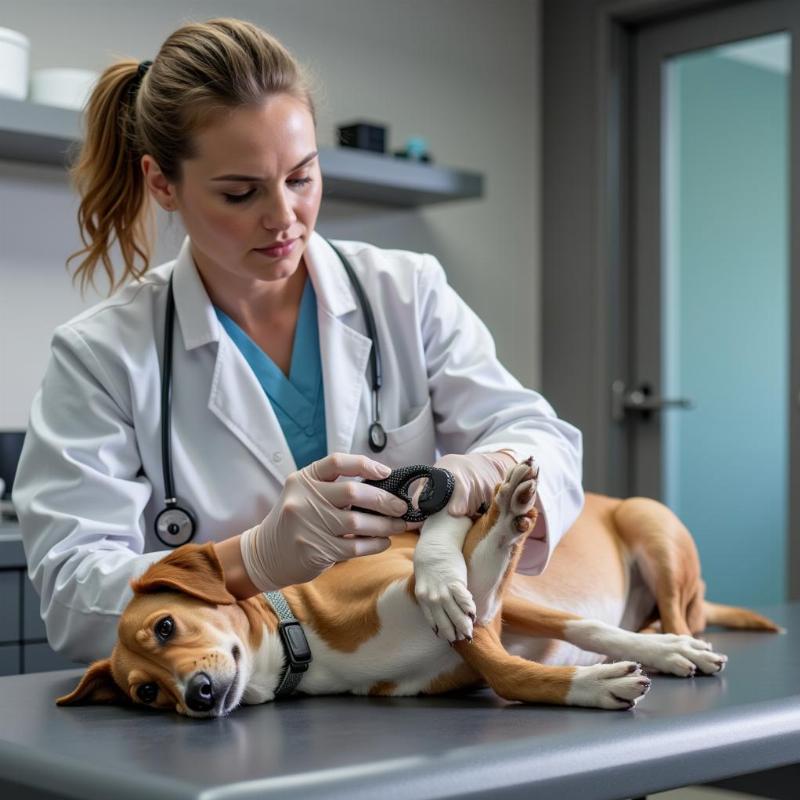A dog’s inability to retract his penis, also known as paraphimosis, can be a concerning situation for any pet owner. While sometimes a temporary issue, it can indicate a more serious underlying problem. This article will guide you through the potential causes, treatment options, and when to seek immediate veterinary care for a dog experiencing paraphimosis.
Understanding Why a Dog’s Penis Won’t Go Back In
Several factors can contribute to paraphimosis in dogs. Understanding these can help determine the severity of the situation and the appropriate course of action.
- Hair Rings: Especially in long-haired breeds, hair can wrap around the penis, constricting blood flow and preventing retraction. This is a common cause and requires prompt attention.
- Trauma or Injury: An injury to the penis, such as a bite or laceration, can cause swelling and prevent retraction.
- Infection: Infections, both local and systemic, can lead to inflammation and swelling, hindering retraction.
- Anatomical Abnormalities: In some cases, particularly in certain breeds like Bulldogs, a dog may have a naturally narrow prepuce (foreskin) making retraction difficult.
- Priapism: This is a persistent, often painful erection unrelated to sexual stimulation. It can cause the penis to become engorged and unable to retract. This is a serious medical condition requiring urgent veterinary attention.
What to Do if Your Dog’s Penis is Stuck Out
If you notice your dog’s penis is not retracting, it’s crucial to act quickly and calmly.
- Examine the Area: Carefully check for any obvious signs of injury, hair rings, or foreign objects.
- Lubrication: If there are no signs of injury and you suspect the penis is simply dry or irritated, try applying a water-based lubricant like KY Jelly to help with retraction. Never use petroleum-based lubricants.
- Gentle Retraction: If lubrication doesn’t work, you can try gently pushing the penis back into the prepuce. Be extremely gentle and stop immediately if your dog shows any signs of pain or resistance.
- Cold Compress: Applying a cold compress wrapped in a thin towel can help reduce swelling and make retraction easier.
When to Seek Veterinary Care
While some cases of paraphimosis can be resolved at home, others require immediate veterinary attention. Contact your veterinarian or an emergency animal hospital if:
- You cannot retract the penis after gentle attempts.
- You see signs of injury, bleeding, or infection.
- Your dog is in pain or distress.
- The penis appears dark, discolored, or cold to the touch.
- The paraphimosis persists for more than a few hours.
 Dog at Vet for Penis Exam
Dog at Vet for Penis Exam
Veterinary Treatment Options
Depending on the cause of the paraphimosis, your veterinarian may recommend several treatment options, including:
- Manual Retraction: Your vet may be able to retract the penis using specialized techniques and lubrication.
- Hair Removal: If hair rings are the cause, the vet will carefully remove them.
- Medication: Antibiotics may be prescribed for infections, and anti-inflammatory drugs can help reduce swelling.
- Surgery: In severe cases, surgery may be necessary to address anatomical abnormalities or repair damaged tissue.
Preventing Future Occurrences
Taking preventative measures can significantly reduce the risk of paraphimosis in your dog.
- Regular Grooming: Keep the fur around the genital area clean and trimmed, especially in long-haired breeds.
- Hygiene: Clean your dog’s prepuce regularly with a gentle, pet-safe cleanser.
- Regular Veterinary Checkups: Routine exams can help identify any potential problems early on.
Conclusion
Paraphimosis can be a concerning issue for dog owners, but with prompt and appropriate action, most cases can be resolved successfully. Regular grooming, hygiene, and veterinary checkups can help prevent future occurrences. If you notice your dog’s penis won’t retract, don’t hesitate to contact your veterinarian for guidance.
FAQ
- How long can a dog’s penis stay out before it’s a problem? If your dog’s penis doesn’t retract within a few hours, it’s best to seek veterinary care.
- Is paraphimosis always painful for dogs? While not always initially painful, it can become painful as swelling and constriction increase.
- Can I use human lubricant on my dog’s penis? Only use water-based lubricants like KY Jelly. Never use petroleum-based products.
- Is paraphimosis more common in certain breeds? Yes, long-haired breeds and breeds with narrow prepuces are more susceptible.
- Can neutering prevent paraphimosis? Neutering can reduce the frequency of erections, indirectly lowering the risk.
Beautdogs.us is your premier source for comprehensive dog care information, breed-specific guidance, and expert advice on all things dog-related in the US. We are a trusted resource for both new and experienced dog owners, offering valuable insights into pet health, nutrition, training, and much more. Discover the beauty of dog ownership with Beautdogs.us! Contact us today: Email: [email protected], Phone: +1 501-555-7529.